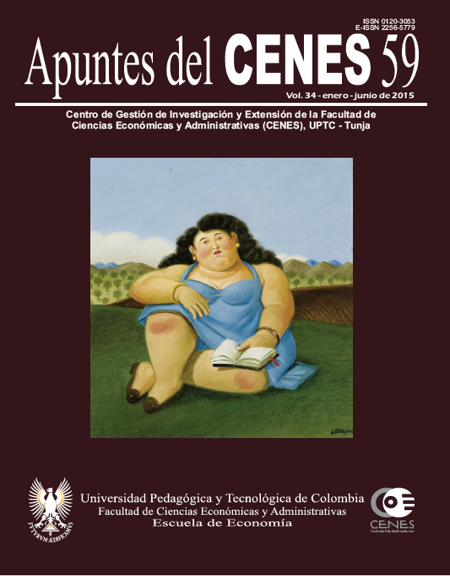Capital structure in medium-sized companies in Department of Boyacá, Colombia

Abstract
The study of capital structure is one of the financial topics of greatest impact, since among the theories that attempt to explain it,has not yet reached a consensus on the determinants and the behavior of funding decisions in companies. Research on the behavior of capital structure in small and medium size companies, is even more complex issue, since traditional models are mainly applicable to trade on the capital markets or in public interest companies.
For this work midsize companies were selected, in the Department of Boyacá in Colombia as study population, applying a model that has been used in similar cases in other countries, in the study has empirically demonstrated preference for equity financing rather than debt, which in turn was preferred by companies with greater volatility in profitability and fastest growing.
Keywords
Capital structure, medium sized companies, funding.
References
- Aybar-Arias, C., Casino-Martínez, A., & López-Gracia, J. (2012). On the adjustment speed of SMEs to their optimal capital structure. Small Bus Econ, 2012(39), 977-996. doi: 10.1007/s11187-011-9327-6
- Baker, M., & Wurgler, J. (2002). Market Timing and Capital Structure. The Journal of Finance, 57(1), 1-32.
- Barona, B., & Gómez, A. (2010). Aspectos conceptuales y empíricos de la financiación de nuevas empresas en Colombia. Cuadernos de Administración, 43, 18
- Berumen, J., García, P., & Domenge, R. (2012). Determinantes de la estructura de capital en la pequeña y mediana empresa familiar en México. Contaduría y Administración, 57(3), 67-96.
- Boot, A. W. A., y& Thakor, A. V. (2011). Managerial Autonomy, Allocation of Control Rights, and Optimal Capital Structure. [rResearch aArticle]. The Review of Financial Studies, 24(10), 3434-‒-3485.
- Bradley, M., Jarrell, G. A., & Kim, E. H. (1984). On the existence of an Optimal Capital Structure Theory and Evidence. The Journal of Finance, 39(3), 857 - 879.
- Comisión económica para América Latina y el Caribe CEPAL. (2011). Política pública e instrumentos de financiamiento a las pymes en Colombia. Santiago de Chile.
- Dang, V. A., Kim, M., y& Shin, Y. (2012). Asymmetric capital structure adjustments: New evidence from dynamic panel threshold models. [iInvestigation]. Journal of Empirical Finance, 10, 405-‒-482.
- Departamento administrativo nacional de estadística DANE. (2012). Informe de coyuntura económica regional ICER Boyacá 2012.
- Forte, D., Barros, L. A., & Nakamura, W. T. (2013). Determinants of the Capital Structure of Small and Medium Sized Brazilian Enterprises. Brazilian Administration Review, 10(3), 347-369.
- Frank, M. y Goyal, V. (2008). Trade-off and Pecking Order Theories of Debt. In B. E. Eckbo (ed.), Handbook of Corporate Finance: Empirical Corporate Finance (pp. 1-85). Amsterdam: Elsevier/North-Holland.
- Leary, M. (2009). Bank Loan Supply, Lender Choice, and Corporate Capital Structure. [rResearch aArticle]. The Journal of Finance, 64(3), 1143-‒-1185.
- Lecuona, V. R. (2014). Algunas lecciones de la experiencia reciente de financiamiento a las pymes. Serie Financiamiento para el desarrollo, 37.
- Lemmon, M., Roberts, M., y& Zender, J. (2008). Back to the Beginning: Persistence and the Cross-Section of Corporate Capital Structure. [rResearch aArticle]. The Journal of Finance, 63(4), 1575-‒-1608.
- Macas Nunes, P., Serrasqueiro, Z., Nunes, A., & Mendes, L. (2013). The Relationship between Growth of Companies and Labour Productivity in Portuguese SMES: A Dynamic Panel Data Approach. Transformations in Business & Economics, 12(3), 20-39.
- Miller, M. H., & Modigliani, F. (1958). The Cost of Capital, Corporation Finance and the Theory of Investment. The American Economic Review, 48(3), 261-297.
- Miller, M. H., & Modigliani, F. (1963). Corporate Income Taxes and the Cost of Capital: A correction. The American Economic Review, 53(3), 433-443.
- Ministerio de Comercio, Industria y Turismo (2012). Perfil Económico del Departamento de Boyacá. Oficina de Estudios Económicos.
- Morellec, E., Nikolov, B. y, & Schürhoff, N. (2012). Corporate Governance and Capital Structure Dynamics. [rResearch aArticle]. The Journal of Finance, 67(3), 803-‒-848.
- Myers, S. C. (1984). The Capital Structure Puzzle. The Journal of Finance, 39(3), 575-‒-592.
- Myers, S. C., & Majluf, N. S. (1984). Corporate financing and investment decisions when firms have information that investors do not have. Journal of Financial Economics, 13, 187-221.
- Palacín-Sánchez, M. J., Ramírez Herrera, L. M., & Di Pietro, F. (2013). Capital structure of SMEs in Spanish Regions. Small Bus Econ, 2013(41), 503-519. doi: 10.1007/s11187-012-9439-7
- Psillaki, M., & Daskalakis, N. (2009). Are the determinants of capital structure country or firm specific? Small Bus Econ, 2009(33), 319-333. doi: 10.1007/s11187-008-9103-4
- Qian, Y., Tian, Y., y Wirjanto, T. (2009). Do Chinese publicly listed companies adjust their capital structure toward a target level? [rResearch aArticle]. China Economic Review, 20, 662-‒-676.
- Stephanou, C., & Rodríguez, C. (2008). Colombia Financiamiento Bancario para las pequeñas y medianas empresas (Pyme). In U. d. g. p. M. y. C. O. R. p. L. y. e. Caribe (Ed.). Bogotá: Banco Mundial.
- Shyam-Sunder, L., & Myers, S. (1998). Testing static tradeoff against pecking order models of capital structure. Journal of Financial Economics, 51, 219-244.
- The World Bank; Internacional Finance Corporation. (2011). Colombia Country Profile 2010. Washington